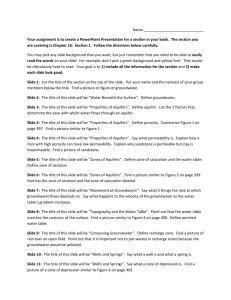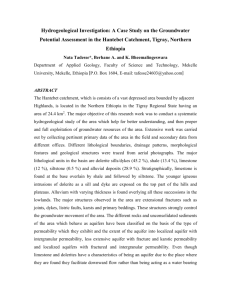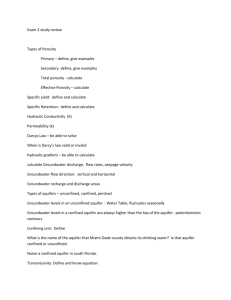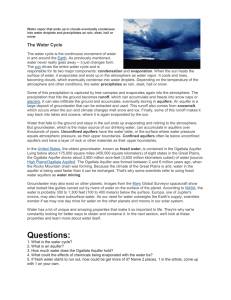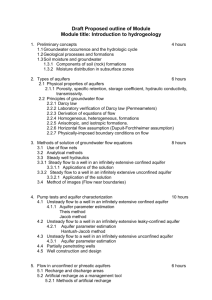Water Security manual PART II, SECTION 5 (Mapping) TABLE OF
advertisement
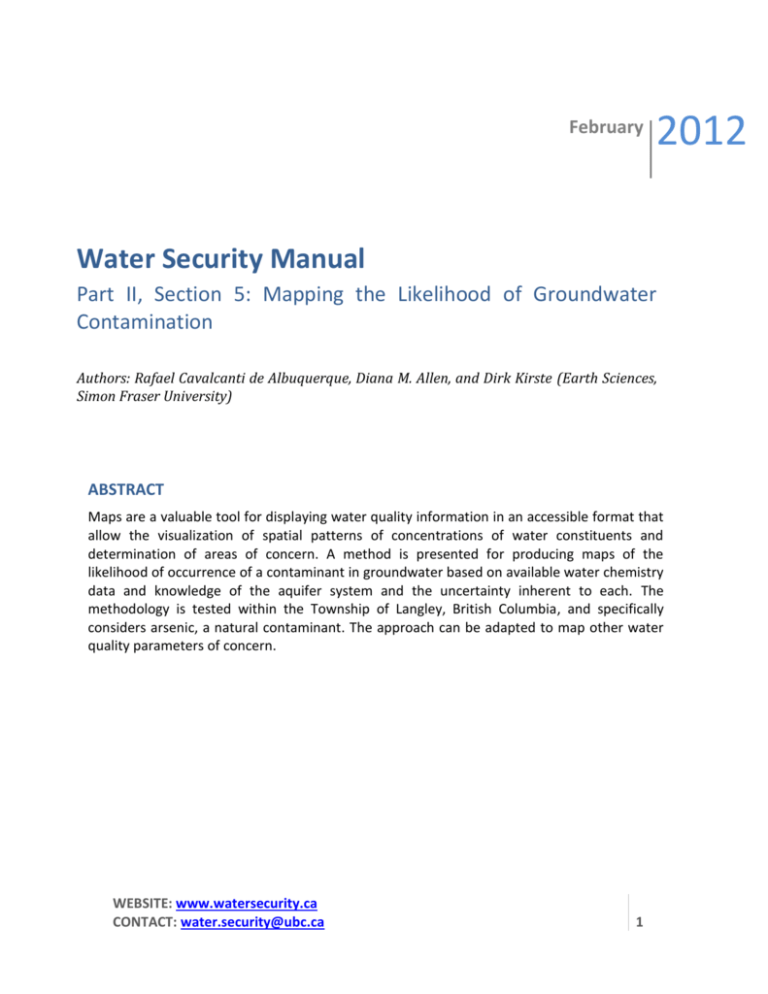
February 2012 Water Security Manual Part II, Section 5: Mapping the Likelihood of Groundwater Contamination Authors: Rafael Cavalcanti de Albuquerque, Diana M. Allen, and Dirk Kirste (Earth Sciences, Simon Fraser University) ABSTRACT Maps are a valuable tool for displaying water quality information in an accessible format that allow the visualization of spatial patterns of concentrations of water constituents and determination of areas of concern. A method is presented for producing maps of the likelihood of occurrence of a contaminant in groundwater based on available water chemistry data and knowledge of the aquifer system and the uncertainty inherent to each. The methodology is tested within the Township of Langley, British Columbia, and specifically considers arsenic, a natural contaminant. The approach can be adapted to map other water quality parameters of concern. WEBSITE: www.watersecurity.ca CONTACT: water.security@ubc.ca 1 WATER SECURITY MANUAL PART II, SECTION 5 (MAPPING) TABLE OF CONTENTS TABLE OF CONTENTS ................................................................................................... 2 Background: Key Issues and Context ........................................................................... 3 Purpose of the Method ............................................................................................... 3 Intended Users ........................................................................................................... 4 Description of Method ................................................................................................ 4 A Step-by-Step Guide to Applying the Method ............................................................ 4 Step 1 – Represent Different Groundwater Environments of the Study Area on a Map .............5 Step 2 – Represent Geochemical Interpretation Spatially on a Map ...................................................5 Step 3 – Represent Confidence of Interpretation Spatially .....................................................................6 Step 4 – Represent Likelihood of Occurrence of the Constituent on a Map .....................................7 Example/Application of the Method ........................................................................... 7 Study Area....................................................................................................................................................................7 Step 1: Represent Different Groundwater Environments of the Study Area on a Map ...............9 Step 2: Represent Geochemical Interpretation Spatially on a Map .................................................. 10 Step 3: Represent Confidence of Interpretation Spatially .................................................................... 11 Step 4: Represent Likelihood of Occurrence of the Constituent on a Map..................................... 12 Recommendations and Further Areas for Research ................................................... 14 Bibliography ............................................................................................................. 15 Journal articles related to this tool include: Cavalanti de Albuquerque, R., Allen, D.M. and Kirste, D. (in review). A Methodology for Spatially Representing the Likelihood of Occurrence of Natural Contaminants in Groundwater. Submitted to Water Resource Management (September 2011). Thesis related to this tool include: Cavalcanti de Albuquerque, R. (2011). Hydrogeochemical Evolution and Arsenic Mobilization in Confined Aquifers Formed within Glaciomarine Sediments. MSc Thesis, Department of Earth Sciences, Simon Fraser University, 207 pp. WEBSITE: www.watersecurity.ca CONTACT: water.security@ubc.ca 2 Background: Key Issues and Context Maps are a valuable tool for displaying water quality information in an accessible format that allow the visualization of spatial patterns of concentrations of water constituents and determination of areas of concern. The production of generalized groundwater quality maps or specific maps that show the likely extent of groundwater contamination typically requires extensive geochemical surveys. Unfortunately, for many regions available groundwater chemistry (or pathogen) data are insufficient for the production of such maps (Vasak et al. 2006). Some of the challenges associated with using groundwater datasets include an insufficient number of samples collected, poor spatial distribution of sample locations, constituents with an elevated method detection limit, and uncertainty in the quality of the data. In addition, the hydrogeology of a particular area of interest may be complex. There may be multiple aquifers (both unconfined and confined) that are poorly delineated or sampled. For these reasons, maps showing only raw concentration data may not appropriately represent occurrences of a constituent in groundwater over the entire region. Rather, integrative approaches, which take into account knowledge of the aquifer system and uncertainty in interpretations, can augment raw groundwater quality data to provide a spatial representation of the likelihood of occurrence of particular constituents in groundwater. Purpose of the Method This mapping tool consists of a method of classifying aquifers and spatially representing the likelihood of occurrence of a specific constituent in groundwater at the scale of a municipality or watershed. In the method, geochemical interpretations are incorporated in addition to raw groundwater quality data to account for aquifers with insufficient groundwater chemistry samples available. Aquifers are also classified based on data quality and confidence of interpretation (or uncertainty), as groundwater information available for each aquifer within a given study area may vary. This document focuses specifically on the chemical constituent arsenic, which is hazardous to human health when present at elevated concentrations in groundwater (i.e. above 10 µg/l, the Canadian Drinking Water Guideline for arsenic). However, the approach can be adapted to map other chemical water quality parameters of concern, which may be natural (e.g. arsenic) or anthropogenic (e.g. nitrate from fertilizer application or septic system sources) or a combination of both; for example, chloride from road salt application versus remnant seawater. Its use for mapping biological contaminants, such as pathogens, has not been tested here, but in principle, such WEBSITE: www.watersecurity.ca CONTACT: water.security@ubc.ca 3 WATER SECURITY MANUAL PART II, SECTION 5 (MAPPING) contaminants could also be mapped. The method could also be adapted to map water quality indictors, such as the CCME (Canadian Council of Ministers of Environment) Water Quality Index (refer to Part II Section 4 – page 14-16). In all cases, raw water quality data are used in conjunction with knowledge of the aquifer system to map the likelihood of contamination. Intended Users This method is primarily aimed at hydrogeologists or groundwater geochemists who may be working with communities to map groundwater quality data. While raw water quality data could be mapped by a non-specialist, the interpretive component of the methodology will benefit from the expertise of a professional with experience in hydrogeology or groundwater geochemistry. The approach can be adapted to the level of expertise in the use of Geographical Information Systems (GIS) in that digital spatial datasets are not necessarily needed. A simple approach would be to use available maps of aquifers in the area, knowledge of their depths and whether they are unconfined or confined, along with available water quality data. Description of Method Two components are used to classify the aquifers in the map produced: 1) interpretations provided through hydrogeochemical studies; and 2) raw groundwater chemistry data. The approach consists of a series of steps for generating maps that highlight different groundwater chemical environments in the study area, geochemical interpretation for likelihood of occurrence of a particular constituent, confidence of interpretation, and raw concentration data. These maps are then superimposed to produce a map showing the likelihood of occurrence of a constituent of interest for each aquifer of a study area. A Step-by-Step Guide to Applying the Method Table 1: Summary table outlying the 4 steps to produce the likelihood of occurrence of a groundwater constituent map Step 1 2 3 4 Represent different groundwater environments of the study area on a map Represent interpretation spatially on a map Represent confidence of interpretation spatially on a map Represent likelihood of occurrence of constituent on a map (superimposition WEBSITE: www.watersecurity.ca CONTACT: water.security@ubc.ca 4 WATER SECURITY MANUAL PART II, SECTION 5 (MAPPING) of the maps produced through steps 1 to 3 and raw groundwater chemistry data) Step 1 – Represent Different Groundwater Environments of the Study Area on a Map In many areas, there is more than one aquifer and understanding how well the aquifers are connected to surface recharge and to each other is critical for evaluating water security. Unconfined aquifers are exposed at surface, meaning that the permeable materials comprising the aquifer are not protected by a cover of lower permeability materials that can act as a barrier to entry of contaminants introduced at surface. Confined aquifers, in contrast, are overlain by a low permeability layer. In areas with a complex hydrogeology, an unconfined aquifer at surface may overlie a series of confined aquifers at different depths that may themselves be variably connected. Aquifers and the confining units may be comprised of unconsolidated materials (e.g. sands, gravels, silts, clays) or consolidated materials (e.g. rock). In the case of rock aquifers, fractures can create permeable pathways into and between aquifers. Where more than one aquifer has been identified in a study area, these different aquifers must first be grouped into unique “groundwater zones”. Grouping of aquifers into zones is done based on physical and chemical properties that are common among a given set of aquifers. Physical and chemical properties used as criteria for grouping aquifers should be relevant to the occurrence of the constituent of interest in groundwater, according to geochemical interpretations. Some examples of physical and chemical properties of aquifers that may be used as criteria for grouping aquifers are listed below: Unconfined aquifers versus confined aquifers Sediment or rock types forming aquifers and confining units Geographical location of aquifers Depth from surface to aquifers Susceptibility of aquifers to contaminants introduced at surface Groundwater chemistry (this may include a number of different criteria, such as water type, redox potential, pH, salinity, concentration of specific constituents, etc.) Step 2 – Represent Geochemical Interpretation Spatially on a Map Each groundwater zone defined in step 1 is assessed as either having the constituent of interest ‘likely’ or ‘unlikely’ to occur in groundwater. This assignment is done based on WEBSITE: www.watersecurity.ca CONTACT: water.security@ubc.ca 5 WATER SECURITY MANUAL PART II, SECTION 5 (MAPPING) interpretations provided through a geochemical study1. Raw concentration data are not used in this step. Where a geochemical study has not been undertaken, the available chemistry data may be visually associated with different aquifer zones. For example, there may be clusters of wells with high concentrations of a particular constituent that can be associated with a particular aquifer. The benefit of a geochemical study is that the reasons why certain constituents are found at elevated (or low) concentrations may be determined. The assignment of a constituent as ‘likely’ or ‘unlikely’ to occur is applied to the entire area of each groundwater zone, and not to portions of zones. If it appears that the constituent of interest is likely to occur in part of a zone, but unlikely to occur in another part of the same zone, then step 1 should be revisited. In this case, the groundwater zone in question should be divided into two or more zones. Step 3 – Represent Confidence of Interpretation Spatially In step 3, different levels of confidence in the geochemical interpretation are represented on a map. This representation is based on availability of groundwater chemistry data within each aquifer. This step is taken in order to represent uncertainty in the geochemical interpretation as it pertains to likelihood of contamination. Three levels of confidence are used: high, medium and low confidence. High confidence is assigned as points on a map, while medium and low levels of confidence are assigned to aquifer polygons (i.e. the mapped extents of aquifers). High Confidence: High confidence points are assigned at every sampling location where the data collected are of a satisfactory quality. Medium Confidence: Medium confidence is assigned to aquifer polygons where sufficient groundwater chemistry data are available, and where the hydrogeological and geochemical controls on groundwater quality are well understood. Low Confidence: Low confidence is assigned to areas with insufficient or no available groundwater chemistry data, or where the hydrogeology and hydrogeochemistry are poorly understood. The assignment of areas with medium or low confidence is independent of the groundwater zones assigned in step 1. Hence, it is possible for parts of a groundwater zone to be assigned a low level of confidence of interpretation, and other parts of the same zone assigned a medium level of confidence. Note that assigning confidence is at 1 A geochemical study involves sampling groundwater, analyzing the water for its chemical constituents, and interpreting the results based on the hydrogeology of the area and the chemical processes that may control the concentrations of the constituents. WEBSITE: www.watersecurity.ca CONTACT: water.security@ubc.ca 6 WATER SECURITY MANUAL PART II, SECTION 5 (MAPPING) the discretion of the mapper, in that some determination of what constitutes sufficient data available or well understood hydrogeology and hydrogeochemistry is needed. Step 4 – Represent Likelihood of Occurrence of the Constituent on a Map In step 4, the raw concentration data of the constituent of interest are superimposed over the interpretation map produced in step 2 and the confidence of interpretation map produced in step 3. The result of this superimposition (the final product) is a map showing aquifer polygons (outlines) that can be colour-coded based on likelihood of occurrence of the constituent of interest; for example, a hatch pattern may be coded based on the confidence of interpretation. Colour, shape or size coded data points may be displayed on the map based on the concentration of the constituent of interest. Likelihood of occurrence of a constituent is determined based on the superimposed raw concentration data with the interpretation map. Three levels of likelihood of occurrence are assigned to aquifer polygons on the map: high, medium and low. High Level of Likelihood: High level of likelihood is assigned to aquifer polygons displayed on the interpretation map (step 2) as having the constituent of interest likely to occur, and that have the vast majority of its data points at concentrations above the guideline. Medium Level of Likelihood: Medium level of likelihood is assigned to aquifer polygons displayed in the interpretation map as having the constituent of interest likely to occur, and that have a significant number of data points at concentrations below the guideline. Low Level of Likelihood: Low level of likelihood is assigned to aquifers that are both interpreted to not have the constituent likely to occur, and that also have most of the data points at concentrations below the guideline. Example/Application of the Method A case study is presented as an example to illustrate the likelihood of natural arsenic occurrences in groundwater in different aquifers in Langley and Surrey, Lower Fraser Valley, British Columbia. Study Area The study area primarily includes the Township of Langley, as well as the eastern portion of the City of Surrey (more specifically the Nickomekl-Serpentine Valley, including Cloverdale), in the Lower Fraser Valley of British Columbia (Figure 1). The population of the Township of Langley is over 100,000 people (Township of Langley, 2007), and the population of Cloverdale, in the City of Surrey, is approximately 50,000 people (BC Stats, 2005). In the Township of Langley, approximately 18,000 residents rely on private wells WEBSITE: www.watersecurity.ca CONTACT: water.security@ubc.ca 7 WATER SECURITY MANUAL PART II, SECTION 5 (MAPPING) and community wells as source of water, while 82,000 residents use water supplied through the Greater Vancouver Water District and 16 wells owned by the Township (Township of Langley, 2007). Four different groundwater chemistry datasets were available for this particular study area, all of which include arsenic concentration as one of the measured parameters. One dataset consists of water quality data collected by Cavalcanti de Albuquerque (2011), which focused on arsenic occurrences in groundwater in the study area. This dataset has 46 water well sampling locations, sourcing both confined and unconfined aquifers. It is the most complete of the four available datasets in terms of chemical parameters measured, as it contains major and minor elements, and some trace elements, as well as field measured parameters including pH, Eh, conductivity, temperature, dissolved oxygen, and redox sensitive species (arsenite, ferrous iron, ammonia and hydrogen sulphide gas). It is also the dataset with the best data quality, as it used the most up to date sampling and analytical methods. A second dataset consists of water quality data collected during a study by Wilson et al. (2008). It includes data from 98 sampling wells, sourcing both confined and unconfined aquifers. A total 51 parameters, including major and minor elements, are included in this dataset; however, it lacks field measured parameters as samples were submitted for analysis by well owners (conductivity and pH were measured in the laboratory). A third dataset is the Environmental Monitoring System (EMS) dataset maintained by the British Columbia Ministry of Environment (BC MoE 2008). It contains samples collected periodically as part of the groundwater sampling program conducted by the MoE, as well as other unknown sources. A total of 35 sampling locations from the study area are included in the EMS dataset. These are mostly sourced from unconfined aquifers, with few samples sourced from confined aquifers. Data completeness is quite variable in the EMS dataset, as some samples contain more than 40 measured inorganic parameters, while some samples have only 10 parameters. The fourth database is the Township of Langley’s Private Well Network (PWN). It contains 1,045 samples in the Township only, with some samples sourced from the same well. Each sample has up to 37 parameters analyzed; however, data completeness is very variable in this dataset. Sampling and analytical methods used with the PWN dataset are unknown. It is likely that most samples in the PWN were collected by well owners and submitted to a laboratory for analysis; however, no information is given on the sampling method to verify its appropriateness. For this reason, the PWN is considered to be the dataset with the poorest data quality amongst the four datasets available for the study. WEBSITE: www.watersecurity.ca CONTACT: water.security@ubc.ca 8 WATER SECURITY MANUAL PART II, SECTION 5 (MAPPING) Figure 1: Case study area, the Township of Langley shown in the Lower Fraser Valley, British Columbia. The mapped aquifers extend slightly outside this boundary to the east in the eastern portion of the City of Surrey and to the west in Abbotsford. Step 1: Represent Different Groundwater Environments of the Study Area on a Map The hydrogeology of the case study region consists of a complex network of confined and unconfined aquifers comprised of marine, glaciomarine, glaciofluvial and postglacial Quaternary sediments that are several hundreds of metres thick and overlie Tertiary bedrock (Halstead 1986). A total of 45 permeable units forming 18 major confined and unconfined aquifers have been identified in this area (Golder & Associates 2004). These aquifers differ from each other through a variety of physical and chemical characteristics, as they are comprised of different sediment types, have variable natural water quality, and have different levels of susceptibility to contaminants that may be introduced at the land surface (Halstead 1986). A hydrogeochemical assessment of groundwater in this region (Cavalcanti de Albuquerque 2011) demonstrated that arsenic concentrations in most groundwater samples sourced from confined aquifers are above 10 µg/l (the Canadian Drinking Water WEBSITE: www.watersecurity.ca CONTACT: water.security@ubc.ca 9 WATER SECURITY MANUAL PART II, SECTION 5 (MAPPING) Guideline for arsenic), while concentrations in all groundwater samples collected from unconfined aquifers were below 10 µg/l. In this geochemical assessment, it was suggested that most arsenic addition to solution takes place in glaciomarine sediments that form confining units to the confined aquifers. Based on results of the hydrogeochemical assessment two groundwater zones are identified in the case study. One groundwater zone (Zone 1) is comprised of all unconfined aquifers, while a second zone (Zone 2) consists of all confined aquifers. The spatial distribution of these two zones is displayed on a grayscale-coded map (Figure 2). Figure 2: Map showing aquifers classified based on their groundwater zone. Zone 1 is comprised of all unconfined aquifers, whereas Zone 2 is comprised of all confined aquifers. Step 2: Represent Geochemical Interpretation Spatially on a Map As described above, it was determined that there is no tendency for arsenic to occur at elevated concentrations in groundwater in unconfined aquifers. It was also determined that there is a tendency for arsenic to occur at elevated concentrations in groundwater in confined aquifers. Hence, Zone 1 (all unconfined aquifers) is assigned as having WEBSITE: www.watersecurity.ca CONTACT: water.security@ubc.ca 10 WATER SECURITY MANUAL PART II, SECTION 5 (MAPPING) arsenic unlikely to occur in groundwater, while Zone 2 (all confined aquifers) is assigned as having arsenic likely to occur in groundwater (Figure 3). Figure 3: Based on interpretations provided through the geochemical study (Cavalcanti de Albuquerque 2011), Zone 1 (unconfined aquifers) is assigned as having arsenic unlikely to occur in groundwater, while zone 2 (confined aquifers) is assigned as having arsenic likely to occur in groundwater Step 3: Represent Confidence of Interpretation Spatially In step 3, different levels of confidence in the geochemical interpretation are represented on a map. As noted above, four groundwater chemistry datasets were available for this study. Of these, the methods used for collecting and analyzing samples are known for the datasets collected through Cavalcanti de Albuquerque (2011) and Wilson et al. (2008), and for the majority of the data in the Environmental Monitoring System (EMS) dataset. The methods applied to collect the data for the PWN dataset are unknown. Thus, data points sourced for the first three datasets are assigned high confidence data points, while data points from the PWN dataset are assigned low confidence, and are not included as points in the confidence map. WEBSITE: www.watersecurity.ca CONTACT: water.security@ubc.ca 11 WATER SECURITY MANUAL PART II, SECTION 5 (MAPPING) A major confined aquifer in the west of the study area, a group of confined aquifers in the south, and two major unconfined aquifers in the center of the study area are assigned medium confidence of interpretation as a significant number of groundwater samples were collected from these aquifers. The remaining aquifers are assigned low confidence of interpretation (Figure 4). Figure 4: Confidence of interpretation map. Sample locations sourced from data collected by Cavalcanti de Albuquerque (2011), Wilson et al. (2008) and the Environmental Monitoring System (EMS) dataset (British Columbia Ministry of Environment 2008) are identified as high confidence points. Aquifers with many samples deriving from these datasets are classified medium confidence of interpretation, while aquifers with few samples are classified low confidence of interpretation. Step 4: Represent Likelihood of Occurrence of the Constituent on a Map The likelihood of arsenic occurrence map for Langley and Surrey consists of the superimposed interpretation map, the confidence of interpretation map, and the data points from three reliable datasets (Figure 5). All samples sourced from unconfined aquifers have arsenic at concentrations below the Drinking Water Guideline (10 g/l). In step 2, these aquifers were classified as having arsenic unlikely to occur in groundwater; WEBSITE: www.watersecurity.ca CONTACT: water.security@ubc.ca 12 WATER SECURITY MANUAL PART II, SECTION 5 (MAPPING) hence, these unconfined aquifers all have a low likelihood of arsenic occurrence in the final map (Figure 5). In step 2, all confined aquifers were classified as having arsenic likely to occur in groundwater. Most of the samples sourced from the major confined aquifer in the west of the study area have arsenic at concentrations above the guideline. Likewise, a significant number of samples collected from a confined aquifer in the south of the study area have arsenic above the guideline. These aquifers are classified as high likelihood of arsenic occurrence in groundwater (Figure 5). The confined aquifers located in the center and in the eastern part of the study area contain a number of samples with arsenic above the guideline, but also a significant number of samples with arsenic at concentrations below the guideline. For this reason, they are classified as medium likelihood of arsenic occurrence. Finally, there are some deep confined aquifers that lie in between the major deep confined aquifer in the west of the study area and the confined aquifers in the center of the study area that are classified as medium likelihood of arsenic occurrence. These deep confined aquifers were identified as having a low confidence of interpretation due to few sample locations. The fact that these aquifers are deep and confined possibly indicates that they have similar conditions as the major deep confined aquifer in the west, which was classified as high likelihood of arsenic occurrence. The few samples collected from these aquifers have arsenic at concentrations above the guideline value. For these reasons these aquifers are classified as high likelihood of arsenic occurrence (Figure 5). WEBSITE: www.watersecurity.ca CONTACT: water.security@ubc.ca 13 WATER SECURITY MANUAL PART II, SECTION 5 (MAPPING) Figure 5: Map showing likelihood of arsenic occurrence in groundwater in aquifers in Langley and Surrey. Arsenic concentration data points are sourced from Cavalcanti de Albuquerque (2011), Wilson et al. (2008), and the EMS dataset. This is the final product of the method presented. Recommendations and Further Areas for Research The methodology presented herein has only been tested in the Langley/Surrey region of British Columbia. Likewise, the method only considered the likeliness of occurrence of arsenic in groundwater. However, the method can be adapted to other groundwater constituents, for example, nitrate. In this particular study area, the likelihood of occurrence of nitrate would be greater in unconfined aquifers, as these are exposed at ground surface and are unprotected by confining layers. However, nitrate is a highly mobile constituent, and high concentrations have been found in deeper portions of the aquifer system (Carmichael et al. 1995). WEBSITE: www.watersecurity.ca CONTACT: water.security@ubc.ca 14 Bibliography British Columbia Ministry of Environment. 2008. Environmental Monitoring System (EMS) database. http://www.env.gov.bc.ca/emswr/ (accessed July 2011). British Columbia Stats. 2005. Provincial electoral district profile based on the 2001 census, May 15, 2001, Surrey-Cloverdale. BC Stats. Carmichael, V., Wei, M. and Ringham, L. 1995. Fraser Valley Groundwater Monitoring Program Final Report: Ministry of Environment Lands and Parks. Cavalcanti de Albuquerque, R. 2011. Hydrochemical Evolution and Arsenic Mobilization in Confined Aquifers Formed within Glaciomarine Sediments. MSc thesis, Department of Earth Sciences, Simon Fraser University, 207 pp. Golder & Associates. 2004. Final Report on Comprehensive Groundwater Modeling Assignment, Township of Langley: Golder & Associates Ltd. Halstead, E.C. 1986. Ground Water Supply - Fraser Lowland, British Columbia. National Hydrology Research Institute Paper No. 26, IWD Scientific Series No. 146, National Hydrology Research Centre, Saskatoon, 80 Township of Langley, 2007. Water Quality Report. Vasak, S., Brunt, R., Griffioen, J., 2006. Mapping of hazardous substances in groundwater on a global scale. In: Arsenic in Groundwater - a World Problem. Netherlands National Committee - International Association of Hydrogeologists (NNC-IAH): 82-92. Wilson, J.E., Brown, S., Schreier, H., Scocill, D., Zubel, M., 2008. Arsenic in Groundwater Wells in Quaternary Deposits in the Lower Fraser Valley of British Columbia. Canadian Water Resources Journal 33: 397-412 WEBSITE: www.watersecurity.ca CONTACT: water.security@ubc.ca 15

